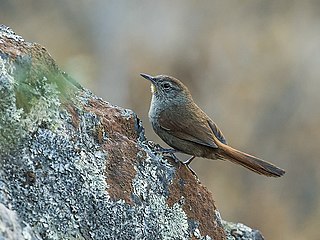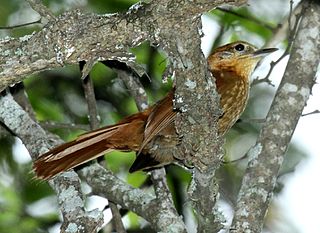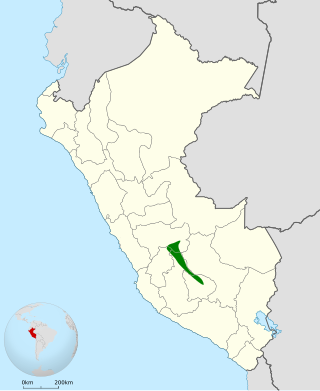
The Cipo canastero is a Near Threatened species of bird in the Furnariinae subfamily of the ovenbird family Furnariidae. It is endemic to Brazil.

Canasteros and thistletails are small passerine birds of South America belonging to the genus Asthenes. The name "canastero" comes from Spanish and means "basket-maker", referring to the large, domed nests these species make of sticks or grass. They inhabit shrublands and grasslands in temperate climates from the lowlands to the highlands. They feed on insects and other invertebrates gleaned from the ground or the low vegetation.

The rusty-vented canastero, or creamy-breasted canastero, is a species of bird in the Furnariinae subfamily of the ovenbird family Furnariidae. It is found in Argentina and Bolivia.

The many-striped canastero is a species of passerine bird in the Furnariinae subfamily of the ovenbird family Furnariidae. It is found in Colombia, Ecuador, and Peru.

The maquis canastero, or canastero andino, is a species of bird in the Furnariinae subfamily of the ovenbird family Furnariidae. It is found in Argentina and Bolivia.

The cordilleran canastero is a species of bird in the Furnariinae subfamily of the ovenbird family Furnariidae. It is found in Argentina, Bolivia, Chile, and Peru.

The rusty-fronted canastero is a species of bird in the Furnariinae subfamily of the ovenbird family Furnariidae. It is endemic to Peru.

The canyon canastero is a species of bird in the Furnariinae subfamily of the ovenbird family Furnariidae. It is found in Chile and Peru.

The sharp-billed canastero or lesser canastero is a species of bird in the Furnariinae subfamily of the ovenbird family Furnariidae. It is found in Argentina, Bolivia, Chile, Paraguay, and Uruguay, and has also occurred as a vagrant in Brazil.

The line-fronted canastero is a Near Threatened species of bird in the Furnariinae subfamily of the ovenbird family Furnariidae. It is found in Bolivia and Peru.

The Itatiaia spinetail, also known as the Itatiaia thistletail, is a species of bird in the Furnariinae subfamily of the ovenbird family Furnariidae. It is endemic to southeastern Brazil.

The rusty-winged barbtail is a species of bird in the Furnariinae subfamily of the ovenbird family Furnariidae. It is found in Colombia, Ecuador, Peru, and Venezuela.

The ochre-browed thistletail is a species of bird in the Furnariinae subfamily of the ovenbird family Furnariidae. It is endemic to western Venezuela.

The white-chinned thistletail or colicardo barbiblanco is a species of bird in the family Furnariidae. It is found in Colombia, Ecuador, Peru, and Venezuela. Its natural habitats are subtropical or tropical moist montane forests and subtropical or tropical high-altitude grassland.

The black-throated thistletail is a species of bird in the Furnariinae subfamily of the ovenbird family Furnariidae. It is endemic to Bolivia.

The puna thistletail is a species of bird in the Furnariinae subfamily of the ovenbird family Furnariidae. It is found in Peru and Bolivia.

The Vilcabamba thistletail is a species of bird in the Furnariinae subfamily of the ovenbird family Furnariidae. It is endemic to the Vilcabamba Mountains of Peru.

The rufous-necked foliage-gleaner is a Vulnerable species of bird in the Furnariinae subfamily of the ovenbird family Furnariidae. It is found in Ecuador and Peru.

The pale-tailed canastero, is a species of bird in the Furnariinae subfamily of the ovenbird family Furnariidae. It is endemic to Peru.

The Ayacucho thistletail is a species of bird in the Furnariinae subfamily of the ovenbird family Furnariidae. It is endemic to the Department of Ayacucho, Peru.






















